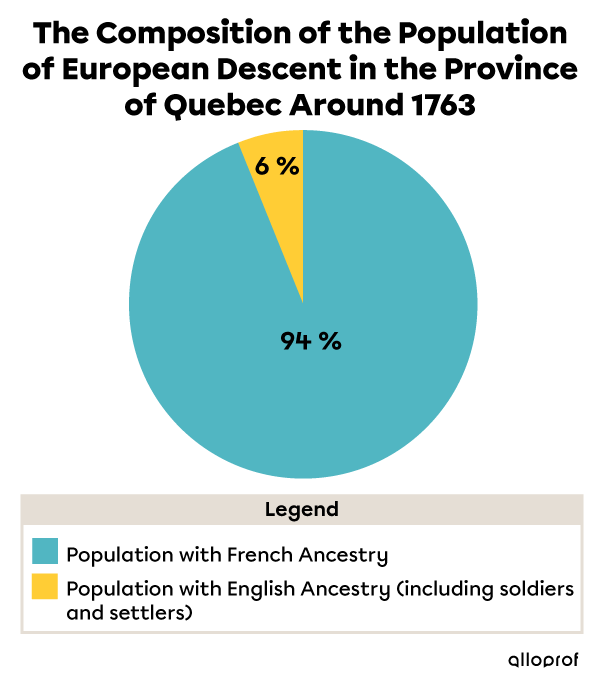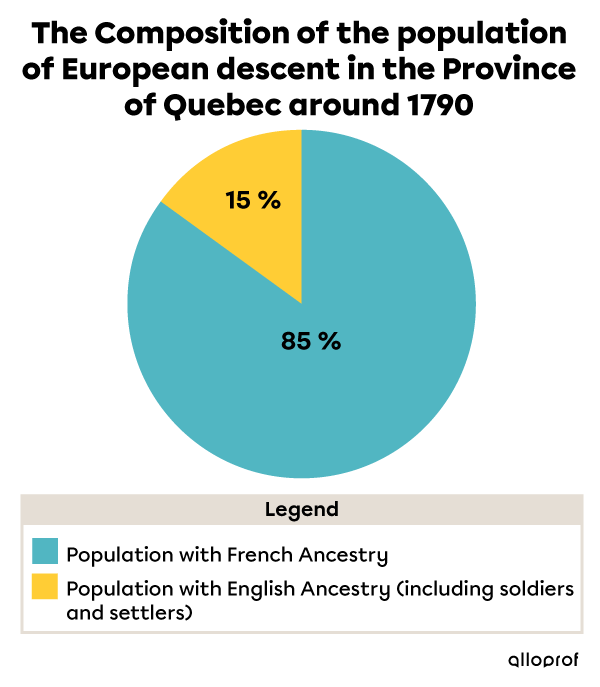Although the Province of Quebec’s population increased from 1760 to 1791, its composition remained almost the same as before. As was the case before the War of the Conquest, most habitants lived in rural areas, mainly around the cities of Quebec and Montreal. For most farming was their primary activity.
Society was still predominantly made up of Canadiens. Since immigration from France had stopped after the War of the Conquest, it was the numerous births that increased the Canadien population.
Immigration is when a person arrives in a foreign country (host country) to settle temporarily or permanently.
It is difficult to estimate the number of Indigenous peoples who lived within the limits of the Province of Quebec territory. They had inhabited this region for a much longer time and their territories did not align with the borders established by the Europeans. Despite this, historians have produced estimates over time. According to Dubois and Morin, the population of Catholic Indigenous peoples in Canada and Acadia was 9 195 in 1763[1].
Even though slaves were not numerous in the colony, they were still a part of the reality of that time. Slaves were primarily Indigenous and Black people. Several groups owned slaves during this era, such as government officials, merchants and priests.
Between 1650 and 1834, the year that slavery was abolished in North America, there were 2 683 Indigenous slaves (Lawrence, 2020). However, the number of slaves decreased following the War of the Conquest compared to their previous numbers in New France.
After the War of the Conquest, the number of Black slaves was almost identical as during the French Regime period. The arrival of the Loyalists in Canada increased the number of slaves since some of them owned and brought their slaves with them.
Following the War of the Conquest, very few British people immigrated to the colony despite the British King's desire to increase the British population in the Province of Quebec. Those who did migrate resided mainly in the cities and were merchants, military personnel or government officials. After 1775 and the American Revolution, Loyalist immigration intensified, increasing the proportion of British people in the Province of Quebec. Despite this increase, the Canadiens remained more numerous in the colony.
Migration is the movement of individuals from their place of origin to another location inside or outside the country.

Source of data: Cormier, Goulet, Krysztofiak, Ste-Marie, 2016.

Source of data: Cormier, Goulet, Krysztofiak, Ste-Marie, 2016.
Between 1755 and 1763, 1 500 to 2 000 Acadians escaped deportation and mainly settled in what became the Province of Quebec in 1763 (Government of Canada, 2020). Starting in 1765, the Acadians who had been deported to other British colonies returned to the Province of Quebec where they felt more at home since they were also Francophone and Catholic like the Canadiens. By the end of the 18th century, nearly 8 000 had settled in the colony (Leblanc, 1979).
The Canadien professional bourgeoisie developed in the late 18th century. This new social class was composed of the Canadiens who had liberal professions, such as doctors, notaries and lawyers. General merchants and small-scale entrepreneurs were a small portion of this bourgeoisie. Over the years, the Canadien professional bourgeoisie gained influence in society and its members became the spokespeople for the Canadien population.
Although the Province of Quebec was predominantly Canadian and spoke French, the colony’s official language was English. However, French was the language of international communications in the 18th century. Therefore, the British who formed society’s elites were often bilingual, so regulations were published in French in the colony.
Dubois, P.-A. et Morin, M. (2019). Les populations amérindiennes du Canada, des postes du Domaine du Roy et de l’Acadie, 1680-1763 : un portrait démographique. Recherches amérindiennes au Québec, 49 (1), 45-62. https://doi.org/10.7202/1066760ar
Bernier Cormier, E., Goulet, G., Krysztofiak, V. et Ste-Marie, P. (2016). Chroniques du Québec et du Canada. Des origines à 1840 — 3e secondaire [Manuel de l’élève]. ERPI.
Gouvernement du Canada. (2020, 1er avril). Le grand dérangement. Parcs Canada. https://www.pc.gc.ca/fr/lhn-nhs/nb/beausejour/culture/histoire-history/deportation
Lawrence, B. (2020, 8 mai). Esclavage des Autochtones au Canada. L’encyclopédie canadienne. https://www.thecanadianencyclopedia.ca/fr/article/slavery-of-indigenous-people-in-canada
Leblanc, R. A. (1979). Les migrations acadiennes. Cahiers de géographie du Québec, 23 (58), 99-124. https://doi.org/10.7202/021425ar